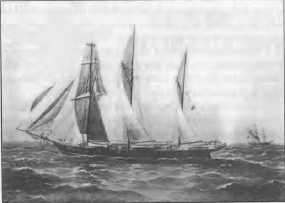- Author
- Rivett, Norman C
- Subjects
- Ship histories and stories
- Tags
-
- RAN Ships
- None noted.
- Publication
- December 1998 edition of the Naval Historical Review (all rights reserved)
Standing at the right-hand side of the main entrance to the Barracks Building of 1888 at Garden Island is the imposing figurehead from HMS Sealark known affectionately by all since 1919 as “Consuela”. A brass plate at the base states:
“Figurehead of HMS Sealark late Wanderer late Consuela. Presented by Commander J. R. Patrick. RANR, on July 1, 1919.”
The plate faithfully reflects the original entry in the Internal Auditors records taking the figurehead on charge and thereby perpetuates two errors. J. R. Patrick was a Master Mariner entitled to the courtesy title of Captain; at the time he was serving as a Lieutenant RANR, at Garden Island whilst Sealark was being prepared for the voyage to Melbourne prior to being disposed of by auction.

Sealark had paid off at Sydney on 10 December 1914 and was laid up alongside Garden Island. During this period she was used by Engineer Commander J. J. Brand, RAN, for experiments associated with the burning of pulverised fuels. At the subsequent auction in Melbourne on September 3, 1919, Sealark was purchased for £2,500 by J. R. Patrick (who founded the Patrick Steamship Company) with her as Sealark III in May 1920.
In June 1922 she was renamed Norwest and the company became Patrick Steamships Ltd. Norwest was converted to a hulk by W. Waugh at Sydney NSW in 1925.
It is of interest to note that when presented to Garden Island Naval Dockyard the figurehead was the property of the Admiralty and when J. R. Patrick purchased the Sealark in “as is” condition she was of course minus the figurehead which technically was never owned by J. R. Patrick. Legally the figurehead is still the property of the Royal Navy.
When first presented to the Dockyard the figurehead was mounted on a pedestal to the right of the entrance gates to Signal Hill, now Hill Road, leading from Office Square to the Northern Hill, where it became a familiar sight until replaced by the figurehead from the “Windsor Castle” of Aberdeen, in the likeness of the young Queen Victoria, on the 21st October (Trafalgar Day) 1932.
Sealark’s figurehead was then moved to the garden on the northern hill where it remained until the early 1960s when it was repositioned on the lawn of the civil Personnel Office (Building 69) at the entrance to the Dockyard. During 1986 the figurehead was removed to the dockyard historic complex, as was the figurehead of the Windsor Castle, both figureheads now stand on the verandah of the Barracks Building, flanking its main entrance.
Other than the mis-spelling of Consuelo and premature promotion of Lieutenant J. R. Patrick, RANR, the brass plate at the base of Sealark s figurehead is a reasonable statement of fact. No implication here that the figurehead represents Consuelo.
Early local records, whilst not making this claim, do nothing to dispel the idea and the misconception has persisted so that generations of Garden Islanders, myself included, affectionately refer to this figurehead as Consuela, or Consuelo, without question.
Who then was Consuelo and how did she become associated with this figurehead? To complicate the issue, there were two ladies named Consuelo with whom a possible connection is claimed, one Cuban, the other American, separated by a generation yet having a unique relationship and a common bond by both becoming British Duchesses.
Consuelo Yznaga, daughter of Antonio Yznaga del Valle, of Louisiana, USA, and Cuba, married Viscount Mandeville in 1876 and when her husband succeeded as the Eighth Duke in 1890, became the Duchess of Manchester. The other was Consuelo Vanderbilt who at 19 years of age married the Ninth Duke of Marlborough in 1895. Consuelo Yznaga had been bridesmaid at the wedding of Alva Erskine Smith and William K. Vanderbilt and when their first child was born in 1876 she was named Consuelo, after Consuelo Yznaga, who became the child’s Godmother.
The first of a number of erroneous accounts of Sealark’s prior history appeared in the Cable News in the Daily Telegraph dated 17 November 1908.
“New Survey Ship for Australia, London – Sunday Afternoon. The British Admiralty has purchased Mr. W. K. Vanderbilt’s yacht Consuela for survey work in Australian waters.”
After being sold out of the service the following account of Sealark appeared in the Sydney Morning Herald dated 7th February 1921.




